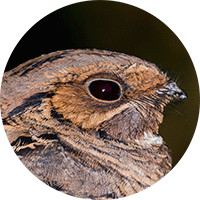Pauraque
The Pauraque (Nyctidromus albicollis) Read in Spanish
Appearance: The Pauraque is a medium-sized nightjar species with cryptic plumage that provides excellent camouflage. It has a mottled brown, gray, and black feather pattern on the upperparts, while the underparts are generally lighter with intricate barring. The bird features a prominent white patch on its throat, which is a distinctive field mark.
Habitat: Pauraques inhabit a variety of habitats such as open woodlands, dry scrublands, savannas, and forest edges. They prefer habitats with adequate ground cover and sparse vegetation to blend in effectively with their surroundings.
Behavior: Pauraques are predominantly nocturnal and crepuscular, being most active at dawn and dusk. They rely on their exceptional camouflage to forage for insects on the ground, capturing prey such as beetles, moths, and other flying insects in mid-air. These birds are adept at remaining motionless, relying on their camouflage to avoid detection during the day.
Breeding: During the breeding season, male Pauraques perform elaborate courtship displays to attract females. They establish territories and advertise their presence through distinctive vocalizations, including a series of melodious whistles, churrs, and clucks. Pauraques typically nest on the ground, laying eggs in a shallow scrape lined with minimal nesting material. Both parents share nesting duties and take turns incubating the eggs and caring for the chicks.
Conservation Status: The Pauraque is considered a relatively common and widespread species. Its populations appear stable, benefiting from a diverse range of habitats across the country.
Distribution
The Pauraque (Nyctidromus albicollis)
Andean Region: Pauraques can be found in the Andean foothills and lower elevations of the Andean mountain range, where they utilize forest edges, open woodlands, and disturbed habitats for foraging and breeding.
Caribbean Region: This species is present in the Caribbean coastal areas of Colombia, where it occupies scrublands, dry forests, and savannas, taking advantage of the diverse habitats found in this region.
Pacific Region: Along the Pacific coast of Colombia, Pauraques are encountered in forest edges, secondary growth forests, and open areas with suitable ground cover, contributing to the avian diversity in this region.
Orinoco Region: The Pauraque occurs in parts of the Orinoco River basin and surrounding lowland areas, utilizing grasslands, savannas, and open woodlands for feeding and nesting activities.
Amazon Region: In the Colombian Amazon region, Pauraques inhabit diverse habitats ranging from primary rainforests to disturbed areas, where they rely on camouflage and nocturnal behaviors to thrive in the dense vegetation of the Amazon basin.
Eastern Plains (Llanos): The open grasslands and savannas of the Eastern Plains provide suitable habitats for Pauraques in Colombia, where they forage for insects and breed in the ground-level vegetation typical of this region.
Taxonomy
The Pauraque (Nyctidromus albicollis)
- Kingdom: Animalia
- Phylum: Chordata
- Class: Aves (Birds)
- Order: Caprimulgiformes
- Family: Caprimulgidae
- Genus: Nyctidromus
- Species: Nyctidromus albicollis
Vocalization
The Pauraque (Nyctidromus albicollis)
Chuckles: Pauraques produce soft, chuckling calls that sound like a low, rolling chuckle. These chuckles are often heard during courtship displays and territorial interactions.
Whinnies: Pauraques emit whinny-like vocalizations that are often described as a series of ascending and descending notes. Whinnies are used in territorial defense and communication between mating pairs.
Clucks: Pauraques also vocalize with quick, rhythmic clucking sounds. These clucks may serve as contact calls or signals of alarm in response to potential threats.
Chips: Pauraques can produce sharp, high-pitched chip notes that are used in various social interactions and during foraging activities.
Calls: Pauraques may deliver a series of melodious whistles and trills that are interspersed with other vocalizations. These calls are often part of the male's courtship display to attract females.



